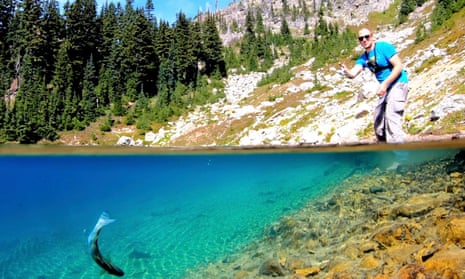There it was again – an all-too-familiar splash in the shallow, rocky portion of the lake, maybe 200 feet along the shore from where I was standing. I had heard it twice already, and seen nothing but circular ripples on the glasslike surface of the water. But this time, I was watching. Just as I’d identified the torpedo-shaped, thrashing object launching from the surface of the water as a massive trout, a second one leapt into the air and snatched at an unfortunate insect.
I was backpacking and fishing deep in the Cascade mountains of Washington state, in search of alpine trout to catch and eat, and to film another adventure for my YouTube channel, NW Fishing Secrets. I’d started my fishing show as a hobby in April 2019, filming instructional videos on how to catch local fish, but as the audience grew rapidly, I realised viewers wanted more than that.
They wanted to feel what it was like to actually be in the wilds. NWFS had become more than a tutorial series – it was now a fishing adventure show, bringing the outdoors into people’s living rooms, allowing viewers who might not be able to visit these remote places to experience them as if they were there with me.
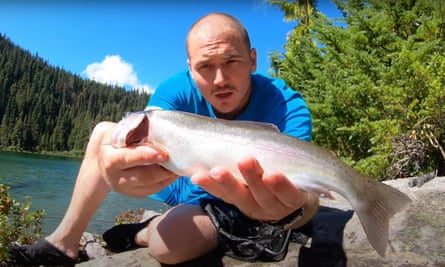
The evening before, I had driven 100 miles from my home near Seattle into the mountains in my self-converted, 1998 yellow campervan. The remote trailhead was another 12 miles up a gravel road crossed by several small creeks. I wanted to get as far away from urban life as I could, to be in a place where it was unlikely I’d see another soul. I wanted to be alone in the mountains. That night I filmed time-lapses of the bright starry sky while getting my camera gear ready for a four-day mountain backpacking and fishing adventure.
The next morning, after a good night’s sleep on the small bed in the back of my van, and a cup of freshly brewed coffee made in my little side-door mounted kitchen, I set off on the trail. I was travelling as light as possible – in my backpack were my pole-less tent, sleeping bag, butane stove, water purifier, first aid kit, fishing rod and reel, lures and various other bits of tackle. However, my video equipment – five cameras, batteries, tripods and a solar charger – must have brought the weight to around 60lbs. “See you in four days,” I mumbled to my van before disappearing into the forest.
After I’d crossed a big creek, wild berry bushes provided a snack and native mushrooms were growing everywhere, so I kept an eye out for edible specimens. Then, gradually, the trail started getting steeper. The beginning is always the hardest part. Several miles up the trail, I heard voices below. As they got louder, I could make out two men on horseback, riding up the trail with a herd of pack mules, carrying enough gear to spend weeks in this vast mountain range.
As I began gaining altitude, the forest opened up enough to give me views of the peaks across the valley. The scenery was a welcome distraction from my pack, which began to feel heavier with every step. Looking out over the endless snow-covered peaks, I realised I had made it deep into the wilderness. There was no town, road or cell service for many miles. It was like a scene from the wild west.
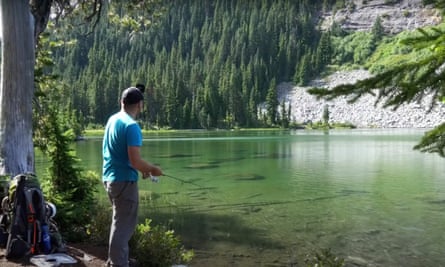
Half a day and several thousand feet of climbing later, I arrived at the first lake of my adventure, and enjoyed a sweet feeling of relief at finally seeing the clear water. The lake was shallow, with large, submerged boulders providing a perfect ambush position for the trout. There were birds chirping along the shore and a few bees buzzing. A light breeze carried through the trees.
The plan was to catch a fish for dinner and set up camp for the night. I tackled up with one of my homemade “bullet lures”, a small spinner using a shiny French blade to attract the fish, attached to a pistol cartridge as its body, which adds weight for long casts.
Casting between the submerged boulders and working my way along the shore, I soon caught my first trout. It was rather small, but having heard several large splashes in the distance, I was confident I would catch a bigger one. I let it go for good luck – always a risky decision when the video I was making relies on having a fish to cook and eat.
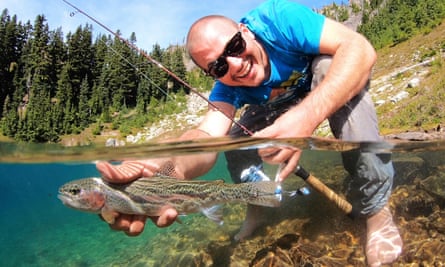
An hour of fishing later, it became obvious I had to move to a new location. And that’s when I saw the two large fish jumping at the end of the lake. I stepped carefully through the huckleberry fields that lay between me and the feeding trout, making as little noise as possible. Sound carries in such a pristine, quiet place and would spook the fish.
A dead tree and a large boulder made up a small peninsula, right where the trout were jumping. I could see every detail in the clear, turquoise water. Sunken logs lay between boulders. Grasses lined the shore. There were insects everywhere. I watched a large dragonfly gracefully hover inches above the water’s surface, right by the submerged boulders. A shadow emerged from the deep. Then, as if in slow motion, the surface opened, followed by a massive trout, its eyes locked on the insect, its powerful tail propelling it from the water. It all ended with a giant splash not 20 feet in front of my eyes. The dragonfly was gone. I now knew how to catch these giant trout.
My father is a biologist specialising in lepidopterology – the study of butterflies and moths. He taught me in the German woods where I grew up how to catch and identify various insects. So, while a dragonfly would prove difficult to trap, I went in search of dragonfly larvae – an underwater, juvenile form of what had just been eaten by these trout. Carefully turning over (and gently placing back) several small, submerged rocks and pieces of bark, I collected three larvae.
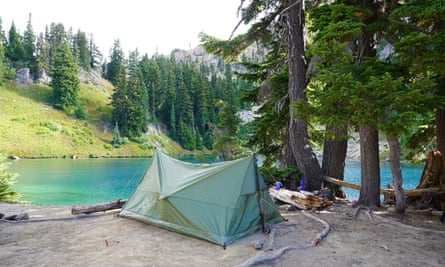
My compact fishing rod was rigged up with a float, which allows you to present your bait to the fish at a set depth. With the dragonfly larvae on the hook and its depth set to 2½ feet under the float, I spotted the trout on the hunt again. I gently cast the larvae about five feet from the feeding fish. Instantly, the dark shadow changed its direction, heading straight for my hook and the slowly wriggling insect. My float dipped below the surface.
The trout thrashed and jumped, then darted in front of a camera I had placed underwater to film the action. Holding the fishing rod in one hand, I reached for my net with the other and gently pulled the fish into it. I could instantly feel the weight of a beautiful, silver-bodied rainbow trout with pronounced pink stripes down its body, and small, dark spots on the top side of its tail. Not only had I just secured dinner, but days of preparing gear, driving, hiking and filming had just turned into a new episode of my show. There are very few things more rewarding than catching or foraging your own food.
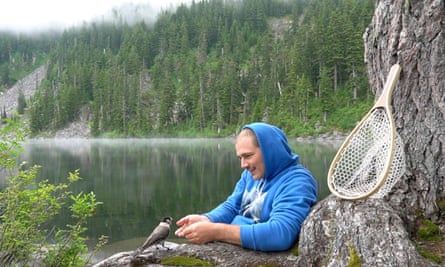
The sun was now setting behind the mountains and I spent the rest of the evening documenting the cleaning of my catch, chopping onions and avocados, and finishing the episode with a delicious trout taco. The best part of all was that it was only day one of my backpacking trip. In the mountains, with no phone reception, internet or television, I feel like I’m on a journey back to simpler times, where I can clear my mind from everyday commotion and noise.
As darkness fell, the stars illuminated the lake and the mountains in front of me. Being too remote for any light pollution, I could see deep into the Milky Way. Exhausted, I crawled into my tent, slipped into my sleeping bag, closed my eyes and was lulled to sleep by the gentle splashing of water against the lake’s shore. I was completely at peace. During these challenging times, moments like this remind me that there is still a beautiful world waiting to be explored every day.
